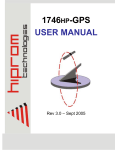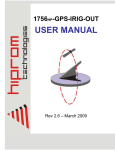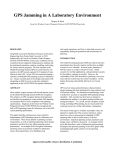Download 1769HP-GPS USER MANUAL
Transcript
1769HP-GPS USER MANUAL Rev 1.1 – June 2005 1769HP-GPS - User Manual Rev 1.0 Table of Contents Chapter 1 Chapter 2 Chapter 3 Chapter 4 Chapter 5 Chapter 6 Chapter 7 Introduction.......................................................................................................3 Module Accessories .........................................................................................4 Module Operation.............................................................................................5 Installing the Module ........................................................................................7 Configuring the Module ....................................................................................8 I/O Address Map ............................................................................................15 Module Status ................................................................................................22 Appendix A Appendix B Appendix C Appendix D Appendix E PLC Ladder Example .....................................................................................23 Specifications .................................................................................................44 GPS Operation...............................................................................................45 Time standards ..............................................................................................49 Glossary .........................................................................................................50 . Page 2 of 51 1769HP-GPS - User Manual Rev 1.0 CHAPTER 1 INTRODUCTION The 1769HP-GPS module provides accurate time and position information and services for the Allen-Bradley 1769 platform (CompactLogix or MicroLogix 1500). The module makes use of Global Positioning System (GPS) technology to derive accurate time which is synchronized with the atomic clocks located on the GPS satellites. This document serves to describe the functionality, installation, configuration and use of the module. . Page 3 of 51 1769HP-GPS - User Manual Rev 1.0 CHAPTER 2 MODULE ACCESSORIES Each 1769HP-GPS package includes the following components: G P S • • • • 1769HP-GPS module 5m RG58 patch lead with a SMA male and TNC male connector on either end 3.3V active 50Ω bullet antenna 1769HP-GPS user manual MODULE GPS GPS G lobal P ositioning & Tim ing Module ANT Figure 2.1 : 1769HP-GPS module with antenna and patch-lead . Page 4 of 51 1769HP-GPS - User Manual Rev 1.0 MODULE OPERATION CHAPTER 3 The 1769HP-GPS module is designed to operate within the Allen-Bradley 1769 backplane. All power required for the module’s operation is derived from the 1769 backplane. G P S MODULE Status LEDs GPS GPS G lobal P ositioning & Tim ing Module SMA Antenna Port ANT Figure 3.1 : 1769HP-GPS Layout The on-board GPS receiver is connected via the external SMA antenna port and external antenna patch-lead to the active GPS antenna. Once the module is powered-up it will begin searching for available GPS satellites. Soon after lock on at least 4 satellites has been achieved the module’s internal time will become valid. . Page 5 of 51 1769HP-GPS - User Manual Rev 1.0 The current status of the module is conveyed to the user by means of the 2 bi-color Status LED’s. The following information is available to the user directly across the backplane by means of a scheduled connection: • • • • • • • Date and Time in Gregorian Format (year, month, day, hour, minute etc.) GPS Receiver Status Number of satellites being tracking Position in Polar Coordinates (latitude, longitude and altitude) Position in Cartesian Coordinates ( Earth-centered-earth-fixed X,Y,Z axis) Velocity in Polar Coordinates (Northerly, Easterly and Upward) Velocity in Cartesian Coordinates ( Earth-centered-earth-fixed X,Y,Z axis) All time and date information can be adjusted to the local time-zone by configuring the Time-Zone offset, in the scheduled output image. . Page 6 of 51 1769HP-GPS - User Manual Rev 1.0 CHAPTER 4 INSTALLING THE MODULE GPS utilizes a spread spectrum signal in the 1.5GHz range, and thus cannot penetrate conductive or opaque surfaces. Thus the antenna should be mounted in a horizontal position with an unobstructed view of the sky. Attach the antenna patch lead to the antenna. It is recommended that waterproofing tape be used to seal the connection. NOTE: Should a longer patch lead be required it is recommended that a GPS signal booster is used. Contact your local Hiprom Technologies distributor for assistance. Attach the patch lead SMA (male) to the module’s SMA (female) connector. It is not recommended that the antenna patch lead exceed a total loss of 10dB at 1.5GHz, as this may increase the time to GPS lock, or in extreme cases, prevent GPS lock from being achieved at all. Once the module has been power up for the first time, it will search for satellites from a cold start (i.e no almanac). The module will take approximately 5 minutes to acquire Lock. Once a complete almanac has been downloaded, the time to achieve fix will be reduced to around 45 seconds. . Page 7 of 51 1769HP-GPS - User Manual Rev 1.0 CHAPTER 5 CONFIGURING THE MODULE The 1769HP-GPS module is supported by Allen Bradley’s MicroLogix 1500 and CompactLogix PLC systems. Because the CompactLogix uses RSLogix 5000 and the MicroLogix 1500 uses RSLogix 500, two different setup procedures are explained below. 5.1 CompactLogix (RSLogix 5000) A direct connection between the controller and the 1769HP-GPS module is required to transfer I/O data to and from the module. In addition the module supports various unconnected messages that can be used to retrieve particular information. Establishing the Direct Connection This section describes the procedures necessary to configure the 1769HP-GPS module within the CompactLogix system. The 1769 Generic Module is used in RSLogix5000 to configure the module. The configuration of the module is detailed in the table below. CommFormat Description Input Output Configuration Data Format Data – INT Connection parameters Instance 101 100 102 Size 19 4 0 Table 5.1 : 1769HP-GPS connection parameters. Request Packet Interval RPI 1 ms Table 5.2 : Local CompactBus connection parameters. The steps required to add a new 1769HP-GPS module are detailed below. . Page 8 of 51 1769HP-GPS - User Manual Rev 1.0 Figure 5.1 : Right-click on I/O Configuration and select New Module Figure 5.2 : Select Generic 1769 Module ( 1769HP-GPS MODULE ) . Page 9 of 51 1769HP-GPS - User Manual Rev 1.0 Figure 5.3 : Configure module’s parameters Figure 5.4 : Right-click on CompactBus Local and select Properties . Page 10 of 51 1769HP-GPS - User Manual Rev 1.0 Figure 5.5 : Configure CompactBus module’s RPI (Requested Packet Interval) Once a modules configuration data has been downloaded to the controller, it will attempt to establish a connection with the module. A connection will fail if there is inappropriate configuration data. . Page 11 of 51 1769HP-GPS - User Manual Rev 1.0 5.2 MicroLogix 1500 (RSLogix 500) A direct connection between the controller and the 1769HP-GPS module is required to transfer I/O data to and from the module. Establishing the Direct Connection This section describes the procedures necessary to configure the 1769HP-GPS module within the MicroLogix 1500 system. Figure 5.6 : Right-click on I/O Configuration and select Open . Page 12 of 51 1769HP-GPS - User Manual Rev 1.0 Figure 5.6 : Left-click on Read I/O Config Before the IO can be read, a connection must be established between RSLogix and the PLC system (Micrologix 1500). Figure 5.7 : Left-click on Read I/O Config . Page 13 of 51 1769HP-GPS - User Manual Rev 1.0 Figure 5.8 : Confirmation that the 1769HP-GPS module has been identified . Page 14 of 51 1769HP-GPS - User Manual Rev 1.0 I/O ADDRESS MAP CHAPTER 6 The input and output image of the 1769HP-GPS module is defined in the following sections. Appendix A and B provide example code and recommended structures that can be used to extract and view the data. 5 4 3 2 1 0 SKY 6 LOC 7 RSV SV Count 8 PPS 9 PDP 10 BAT 11 ANT 12 RSV 13 DTV 14 PEC 0 1 2 3 4 5 6 7 8 9 10 11 12 13 14 15 16 17 18 15 EWH Word NSH Input Image Milliseconds Seconds Minutes Hours Day Month Year Latitude (Sec x 100) Latitude (Minutes) Longitude (Sec x 100) Longitude (Minutes) Altitude (1 x meters) Altitude (10,000 x meters) Velocity North (m/s x 10) Velocity East (m/s x 10) Velocity Up (m/s x 10) Channel SV PRN Pos X (1 x meters) Pos X (10,000 x meters) Pos Y (1 x meters) Pos Y (10,000 x meters) Pos Z (1 x meters) Pos Z (10,000 x meters) Velocity X (m/s x 10) Velocity Y (m/s x 10) Velocity Z (m/s x 10) SV Signal Strength Reserved Figure 6.1 : Connected Input Image . Page 15 of 51 1769HP-GPS - User Manual Rev 1.0 Input Image Description Field/Value SKY Description Visible Sky 0 = Sky not visible or no satellite signals present 1 = Satellite signals available No sky usually indicates that the antenna does not have a clear view of the sky, such as in a building, etc. LOC Satellite Lock 0 = Not tracking sufficient satellites to provide positional fix 1 = Sufficient satellites being tracked to provide positional fix Location Type CompactLogix: Local:s:I.Data[0].0 MicroLogix 1500: I:e.0/0 BIT CompactLogix: Local:s:I.Data[0].1 BIT MicroLogix 1500: I:e.0/1 Typically, tracking 4 satellites is sufficient to provide lock. CompactLogix: Local:s:I.Data[0].2 RSV Reserved for future use PPS Pulse per Second This bit transitions from 0 to 1 precisely every second. The pulse duty cycle is approximately 50%. PDP PDOP OK 0 = Position Dilution of Precision is unacceptable 1 = No Position Dilution of Precision present Position Dilution of Precision occurs when although there are sufficient satellites in lock, 2 or more of them appear to occupy similar positions in the sky and thus the number of effective satellites is decreased. Battery Backup on Boot 0 = No battery backup available on boot-up. 1 = Battery backup available on boot-up. BAT ANT With battery backup enabled the time taken for the GPS module to regain satellite lock is greatly reduced.It is recommended that if the module is not to be used for an extended period that the battery backup be disabled. Antenna OK 0 = Antenna Fault 1 = Antenna OK An Antenna fault will occur if the antenna is not present or has been damaged. RSV BIT MicroLogix 1500: I:e.0/2 Reserved for future use CompactLogix: Local:s:I.Data[0].3 BIT MicroLogix 1500: I:e.0/3 CompactLogix: Local:s:I.Data[0].4 MicroLogix 1500: I:e.0/4 BIT CompactLogix: Local:s:I.Data[0].5 MicroLogix 1500: I:e.0/5 BIT CompactLogix: Local:s:I.Data[0].6 BIT MicroLogix 1500: I:e.0/6 CompactLogix: Local:s:I.Data[0].7 BIT MicroLogix 1500: I:e.0/7 . Page 16 of 51 1769HP-GPS - User Manual Rev 1.0 DTV SV Count PEC Date / Time Valid 0 = Date Time Not Valid 1 = Date Time synchronized with GPS Satellite count Number of Satellites currently being tracked Last Position Vector in ECEF Mode 0 = Position Update in Latitude, Logtitude and Altitude format 1 = Position Update in Earth-Centred-Earth-Fixed X,Y,Z format ECEF Mode can be invoked by setting the ECF bit in the output image. (MicroLogix 1500: O:e.0/1 or CompactLogix: Local:s:O.Data[0].1) EWH Current East / West Hemisphere 0 = Current position in East hemishere 1 = Current position in West hemisphere This flag is Not valid when in ECEF mode is invoked. NSH Current North / South Hemisphere 0 = Current position in North hemishere 1 = Current position in South hemisphere This flag is Not valid when in ECEF mode is invoked. Milliseconds Seconds Minutes Hours Day Real Time Milliseconds Current real time Milliseconds ( 0 - 999 ) Real Time Seconds Current real time Seconds ( 0 - 59 ) CompactLogix: Local:s:I.Data[0].8 BIT MicroLogix 1500: I:e.0/8 CompactLogix: Local:s:I.Data[0].9-12 BIT MicroLogix 1500: I:e.0/9-12 CompactLogix: Local:s:I.Data[0].13 BIT MicroLogix 1500: I:e.0/13 CompactLogix: Local:s:I.Data[0].14 BIT MicroLogix 1500: I:e.0/14 CompactLogix: Local:s:I.Data[0].15 BIT MicroLogix 1500: I:e.0/15 CompactLogix: Local:s:I.Data[1] INT MicroLogix 1500: I:e.1 CompactLogix: Local:s:I.Data[2] INT MicroLogix 1500: I:e.2 Real Time Minutes Current Local time Minutes ( 0 - 59 ) CompactLogix: Local:s:I.Data[3] This is dependent on the configured time zone (MicroLogix 1500: O:e.1 or CompactLogix: Local:s:O.Data[1]) MicroLogix 1500: I:e.3 Real Time Hours Current Local time Hours ( 0 - 23 ) CompactLogix: Local:s:I.Data[4] This is dependent on the configured time zone (MicroLogix 1500: O:e.1 or CompactLogix: Local:s:O.Data[1]) MicroLogix 1500: I:e.4 INT INT Calendar Day of Month Current Local Calendar Day ( 1 - 31 ) CompactLogix: Local:s:I.Data[5] INT This is dependent on the configured time zone (MicroLogix 1500: O:e.1 . Page 17 of 51 1769HP-GPS - User Manual Rev 1.0 Month Year Latitude (PEC = 0) or CompactLogix: Local:s:O.Data[1]) MicroLogix 1500: I:e.5 Calendar Month Current Local Calendar Month ( 1 - 12 ) CompactLogix: Local:s:I.Data[6] This is dependent on the configured time zone (MicroLogix 1500: O:e.1 or CompactLogix: Local:s:O.Data[1]) MicroLogix 1500: I:e.6 Calendar Year Current Local Calendar Year CompactLogix: Local:s:I.Data[7] This is dependent on the configured time zone (MicroLogix 1500: O:e.1 or CompactLogix: Local:s:O.Data[1]) MicroLogix 1500: I:e.7 INT Current Position Latitude Degrees = integer (I:e.9 / 60) Minutes = I:e.9 mod 60 Seconds = I:e.8 / 100 Only Valid if the PEC flag (I:e.0/13) = 0 OR Distance from Earth-centre along the X - axis. X-Position = (I:e.8 + ( I:e.9 x 10,000)) in metres Position X (PEC = 1) INT CompactLogix: Local:s:I.Data[8] – [9] MicroLogix 1500: I:e.8-9 INT Position is calculated with respect to the WGS-84 Earth-Centred Earth-Fixed co-ordinate system. The X-axis is defined as the vector with origin at the earth's centre and passing through the intersection of the equator and Greenwich meridian. Only Valid if the PEC flag (I:e.0/13) = 1 Longitude (PEC = 0) Current Position Longitude Degrees = integer (I:e.11 / 60) Minutes = I:e.11 mod 60 Seconds = I:e.10 / 100 Only Valid if the PEC flag (I:e.0/13) = 0 OR Distance from Earth-centre along the Y - axis. Y-Position = (I:e.10 + ( I:e.11 x 10,000) in metres Position Y (PEC = 1) CompactLogix: Local:s:I.Data[10] – [11] INT MicroLogix 1500: I:e.10-11 Position is calculated with respect to the WGS-84 Earth-Centred EarthFixed co-ordinate system. The Y-axis is defined as the vector with origin at the earth's centre and passing through the equator 90 degrees east of the Greenwich meridian. Only Valid if the PEC flag (I:e.0/13) = 1 Altitude (PEC = 0) Current Position Altiude Altitude= (I:e.12 + ( I:e.13 x 10,000) in metres I:e.13 Only Valid if the PEC flag (I:e.0/13) = 0 OR Position Z (PEC = 1) Distance from Earth-centre along the Y - axis. Z-Position = (I:e.10 + ( I:e.11 x 10,000) in metres CompactLogix: Local:s:I.Data[12] – [13] INT MicroLogix 1500: I:e.12-13 Position is calculated with respect to the WGS-84 Earth-Centred Earth- . Page 18 of 51 1769HP-GPS - User Manual Rev 1.0 Fixed co-ordinate system. The Z-axis is defined as the vector with origin at the earth's centre and passing through the North pole. Only Valid if the PEC flag (I:e.0/13) = 1 Current Northerly Velocity Velocity North / 10 (in m/s) Velocity – North (PEC = 0) Velocity – X (PEC = 1) Velocity – East (PEC = 0) A negative value indicates a Southerly direction of movement. Only Valid if the PEC flag (I:e.0/13) = 0 OR CompactLogix: Local:s:I.Data[14] Speed with respect to the X - axis. X-Velocity / 10.0 (in m/s) MicroLogix 1500: I:e.14 INT The X-axis is defined as the vector with origin at the earth's centre and passing through the intersection of the equator and Greenwich meridian. Only Valid if the PEC flag (I:e.0/13) = 1 Current Easterly Velocity Velocity East / 10 (in m/s) A negative value indicates a Westerly direction of movement. Only Valid if the PEC flag (I:e.0/13) = 0 OR CompactLogix: Local:s:I.Data[15] Speed with respect to the Y - axis. Y-Velocity / 10.0 (in m/s) MicroLogix 1500: I:e.15 INT Velocity – Y (PEC = 1) The Y-axis is defined as the vector with origin at the earth's centre and passing through the intersection of the equator and Greenwich meridian. Only Valid if the PEC flag (I:e.0/13) = 1 Current Upward Velocity Velocity Up / 10 (in m/s) Velocity – UP (PEC = 0) Velocity – Z (PEC = 1) A negative value indicates a Downward direction of movement. Only Valid if the PEC flag (I:e.0/13) = 0 OR CompactLogix: Local:s:I.Data[16] Speed with respect to the Z - axis. Z-Velocity / 10.0 (in m/s) MicroLogix 1500: I:e.16 The Z-axis is defined as the vector with origin at the earth's centre and passing through the intersection of the equator and Greenwich meridian. Only Valid if the PEC flag (I:e.0/13) = 1 GPS Receiver Channel Number These 3 bits indicate which of the GPS's 8 (0-7) channels' data is being displayed. Channel SV PRN INT Because all 8 channels' data is passed with a single word, it is time division multiplexed, showing a different channel every second. The channel number can be used as an indirect addressing pointer, to store the Channel SV PRN and Signal Strengths in the PLC. Satellite Vehicle PRN Identification Number tracked on current channel Each operational GPS satellite has a unique PRN identification number (0-31). CompactLogix: Local:s:I.Data[17].1315 INT MicroLogix 1500: I:e.17/13-15 CompactLogix: Local:s:I.Data[17].812 INT MicroLogix 1500: I:e.17/8-12 . Page 19 of 51 1769HP-GPS - User Manual Rev 1.0 Updated in conjuction with "Channel" described above SV Signal Strength Reserved Satellite Signal Strength on current channel A measure of the satellite signal strength calculated during signal correlation. Signal Strength in (dbHz x 10 ) after correlation. Updated in conjuction with "Channel" described above CompactLogix: Local:s:I.Data[17].0-7 INT MicroLogix 1500: I:e.17/0-7 CompactLogix: Local:s:I.Data[18] Reserved for future use INT MicroLogix 1500: I:e.18 . Page 20 of 51 1769HP-GPS - User Manual Rev 1.0 Output Image 15 14 13 12 11 0 1 2 3 10 9 8 7 6 5 4 3 2 1 0 ECF WORD Reserved Time Zone (Hours x 10) Reserved Reserved Figure 6.2 : Connected Output Image Output Image Description Field ECF Description Select Earth-Centred-Earth-Fixed Mode Setting this bit causes the module to report position and velocity data in Cartesian co-ordinates. Clearing this bit causes th./e module to report position and velocity data in Polar co-ordinates. Time zone Reserved Time Zone Configuration Used to set the module to report in local time standard. Time zone = UTC Offest where the UTC Offest is the difference, in hours, between local time and GMT. E.g. For Pacific Standard Time (GMT - 8) set time zone = 8 Reserved for future use Location Type CompactLogix: Local:s:O.Data[0].0 MicroLogix 1500: O:e.0/0 BIT CompactLogix: Local:s:O.Data[1] INT MicroLogix 1500: O:e.1 CompactLogix: Local:s:O.Data[2] – [3] INT MicroLogix 1500: O:e.2 - 3 The Time zone needs to be copied from a tag (of type real) into the output word. Appendix A and B provide example code and recommended data types. . Page 21 of 51 1769HP-GPS - User Manual Rev 1.0 MODULE STATUS CHAPTER 7 The following sections describe the various status of the module and how they may be determined via the 2 bi-color (Green / Red ) LEDs. Status LEDs LED DESCRIPTION Module Module Status GPS GPS Lock Status STATUS Solid Red Flashing Red Flashing Green Solid Green Solid Red Flashing Red Flashing Green Solid Green MEANING Major Hardware Fault Major Fault Minor Fault Module operating correctly Antenna Failure No Satellite found Busy acquiring satellites Full GPS Lock, positioning and time fixing Table 8.1 : LED status information of the module. . Page 22 of 51 1769HP-GPS - User Manual Rev 1.0 APPENDIX A PLC LADDER EXAMPLE The 1769HP-GPS module is supported by Allen Bradley’s MicroLogix 1500 and CompactLogix PLC systems. Thus ladder examples for RSLogix 500 and RSLogix 5000 are given below. A.1. RSLogix 500 The ladder example on the following pages consists of the following program files: LAD 2 (Page: 23) • Calls all other program files LAD 3 – POSITION (Page 24-29) • Extracts position in either Polar or ECEF format LAD 4 – SIGNAL (Page 30 – 31) • Extracts the satellite signal strengths for all 8 GPS receiver channels LAD 5 – CONFIG (Page 32) • Configures Time Zone The following example code can be downloaded from the Hiprom website. (www.hiprom.com) . Page 23 of 51 1769HP-GPS - User Manual Rev 1.0 . Page 24 of 51 1769HP-GPS - User Manual Rev 1.0 . Page 25 of 51 1769HP-GPS - User Manual Rev 1.0 . Page 26 of 51 1769HP-GPS - User Manual Rev 1.0 . Page 27 of 51 1769HP-GPS - User Manual Rev 1.0 . Page 28 of 51 1769HP-GPS - User Manual Rev 1.0 . Page 29 of 51 1769HP-GPS - User Manual Rev 1.0 . Page 30 of 51 1769HP-GPS - User Manual Rev 1.0 . Page 31 of 51 1769HP-GPS - User Manual Rev 1.0 . Page 32 of 51 1769HP-GPS - User Manual Rev 1.0 . Page 33 of 51 1769HP-GPS - User Manual Rev 1.0 A.2. RSLogix 5000 This Appendix provides a detailed description of recommended data structures that can be used in conjunction with the provided example ladder logic given below. The following example code (and structures) can be downloaded from the Hiprom website. (www.hiprom.com). . Page 34 of 51 1769HP-GPS - User Manual Rev 1.0 . Page 35 of 51 1769HP-GPS - User Manual Rev 1.0 . Page 36 of 51 1769HP-GPS - User Manual Rev 1.0 . Page 37 of 51 1769HP-GPS - User Manual Rev 1.0 . Page 38 of 51 1769HP-GPS - User Manual Rev 1.0 . Page 39 of 51 1769HP-GPS - User Manual Rev 1.0 . Page 40 of 51 1769HP-GPS - User Manual Rev 1.0 A.2.1. Recommended Input Image Structures Data of the 1769HP-GPS can be presented clearly by manipulating and copying the input image to the GPS user-defined data type (UDT) structure. This structure utilizes the following embedded UDT structures (detailed below) • GPS_Status • GPS_Satellite_Information • GPS_Time • GPS_Polar_Position • GPS_Cartesian_Position • GPS_Polar_Velocity • GPS_Cartesian_Velocity Name Status Sat_Info Time Polar_Position Cartesian_Position Polar_Velocity Cartesian_Velocity Temp GPS Data Type GPS_Status GPS_Satellite_Information GPS_Time GPS_Polar_Position GPS_Cartesian_Postion GPS_Polar_Velocity GPS_Cartesian_Velocity REAL[4] Style Decimal Decimal Decimal Decimal Decimal Decimal Decimal Float Table A.1 : GPS UDT Name SKY LOC DIFF PPS PDP BAT ANT RSV DTV SVCOUNT SVCOUNT1 SVCOUNT2 SVCOUNT3 PEC EWH NSH GPS_Status Data Type BOOL BOOL BOOL BOOL BOOL BOOL BOOL BOOL BOOL BOOL BOOL BOOL BOOL BOOL BOOL BOOL Style Decimal Decimal Decimal Decimal Decimal Decimal Decimal Decimal Decimal Decimal Decimal Decimal Decimal Decimal Decimal Decimal Table A.2 : GPS_Status UDT . Page 41 of 51 1769HP-GPS - User Manual Rev 1.0 GPS_Satellite_Information Name Data Type SV_Count INT Channel INT SV PRN INT SV_Signal_Strength INT Style Decimal Decimal Decimal Decimal Table A.3 : GPS_Satellite_Information UDT Name MilliSecond Second Minute Hour Day Month Year GPS_Time Data Type INT INT INT INT INT INT INT Style Decimal Decimal Decimal Decimal Decimal Decimal Decimal Table A.4 : GPS_Time UDT GPS_Polar_Position Name Data Type Latitude_Degrees INT Latitude_Minutes INT Latitude_Seconds REAL Longtitude_Degrees INT Longtitude_Minutes INT Longtitude_Seconds REAL Altitude REAL Style Decimal Decimal Float Decimal Decimal Float Float Table A.5 : GPS_Polar_Position UDT Name X_Position Y_Position Z_Position GPS_Cartesian_Position Data Type REAL REAL REAL Style Float Float Float Table A.6 : GPS_Cartesian_Position UDT . Page 42 of 51 1769HP-GPS - User Manual Rev 1.0 Name Northerly_Velocity Easterly_Velocity Upward_Velocity GPS_Polar_Velocity Data Type INT INT INT Style Decimal Decimal Decimal Table A.7 : GPS_Polar_Velocity UDT Name X_Velocity Y_Velocity Z_Velocity GPS_Cartesian_Velocity Data Type INT INT INT Style Decimal Decimal Decimal Table A.8 : GPS_Cartesian_Velocity UDT . Page 43 of 51 1769HP-GPS - User Manual Rev 1.0 APPENDIX B SPECIFICATIONS Parameter Specification General Module Location Backplane Current RPI General Accuracy Horizontal Altitude Time Hot Start Warm Start Cold Start Antenna Connector Frequency Range Polarization Output Impedance VSWR Axial Ratio Gain Out of Band Rejection Azimuth Coverage Elevation Coverage Coax Type Impedance Any Slot Electrical 165mA @ 5.0V Schedules Connection Paramters 1ms to 750ms GPS Receiver Specification L1 frequency (1575.42 MHz), C/A code (Standard Positioning Service), 8-channel, continuous tracking receiver, 32 correlators <6 meters (50%), <9 meters (90%) <11 meters (50%), <18 meters (90%) ±1ms (±1 RPI) <14 sec. (50%), <18 sec. (90%) <38 sec. (50%), <45 sec. (90%) <90 sec. (50%), <170 sec. (90%) Active Antenna SMA female connector 1575.42 MHz ± 1.023 MHz Right-hand circular polarization (RHCP) 50Ω 2.0 maximum 90°: 4.0 dB maximum; 10°: 6 dB maximum 35 dB ± 3 dB fo: 1575.42 MHz fo ± 20 MHz : 7dB min fo ± 30 MHz : 12dB min fo ± 40 MHz : 20dB min fo ± 100 MHz : 100dB min 360° (omni-directional) 0° to 90° elevation (hemispherical) Antenna Patch Lead RG-58 50Ω . Page 44 of 51 1769HP-GPS - User Manual Rev 1.0 APPENDIX C GPS OPERATION The Global Positioning System (GPS) is a satellite based navigation system operated and maintained by the U.S. Department of Defence. The system consists of a constellation of 24 satellites providing world-wide, 24 hour, three dimensional (3D) coverage. Although originally conceived for military needs, GPS has a broad array of civilian applications including surveying, marine, land, aviation, and vehicle navigation. GPS is the most accurate technology available for vehicle navigation. C.1 4.2 GPS Satellite Message Every GPS satellite transmits the Coarse/Acquisition (C/A) code and satellite data modulated onto the L1 carrier frequency (1575.42 MHz). The satellite data transmitted by each satellite includes a satellite almanac for the entire GPS system, its own satellite ephemeris and its own clock correction. The satellite data is transmitted in 30-second frames. Each frame contains the clock correction and ephemeris for that specific satellite ,and two pages of the 50-page GPS system almanac. The almanac is repeated every 12.5 minutes. The ephemeris is repeated every 30 seconds. The system almanac contains information about each of the satellites in the constellation, ionospheric data, and special system messages. The GPS system almanac is updated weekly and is typically valid for months. The ephemeris contains detailed orbital information for a specific satellite. Ephemeris data changes hourly, but is valid for up to four hours. The GPS control segment updates the system almanac weekly and the ephemeris hourly through three ground-based control stations. During normal operation, the 1769HP-GPS receiver module updates its ephemeris and almanac as needed. The performance of a GPS receiver at power-on is determined largely by the availability and accuracy of the satellite ephemeris data and the availability of a GPS system almanac. C.2 Satellite Acquisition and Time to First Fix 4.3.1 Cold-Start The term “cold-start” describes the performance of a GPS receiver at power-on when no navigation data is available. “cold” signifies that the receiver does not have a current almanac, satellite ephemeris, initial position, or time. The cold-start search algorithm applies to a 1769HP-GPS receiver which has no memory of its previous session (i.e., is powered on without the memory backup circuit connected to a source of DC power). This is the “out of the box” condition of the GPS module as received from the factory. In a coldstart condition the receiver automatically selects a set of eight satellites and dedicates an individual tracking channel to each satellite, to search the Doppler range frequency for each satellite in the set. If none of the eight selected satellites is acquired after a predetermined period of time (time-out), the receiver will select a new search set of eight satellites and will repeat the process, until the first satellite is acquired. As satellites are . Page 45 of 51 1769HP-GPS - User Manual Rev 1.0 acquired, the receiver automatically collects ephemeris and almanac data. The GPS receiver uses the knowledge gained from acquiring a specific satellite to eliminate other satellites, those below the horizon, from the search set. This strategy speeds the acquisition of additional satellites required to achieve the first position fix. The cold-start search sets are established to ensure that at least three satellites are acquired within the first two time-out periods. As soon as three satellites are found, the receiver will compute an initial position fix. The typical time to first fix is less than 2 minutes. A complete system almanac is not required to achieve a first position fix. However, the availability and accuracy of the satellite ephemeris data and the availability of a GPS almanac can substantially shorten the time to first fix. 4.3.2 Warm Start In a warm-start condition the receiver has been powered down for at least one hour but has stored a current almanac, an initial position, and time, in memory. When connected to an external back-up power source (battery back-up), the 1769HP-GPS receiver retains the almanac, approximate position, and time to aid in satellite acquisition and reduce the time to first fix. During a warm start, the 1769HP-GPS receiver identifies the satellites which are expected to be in view, given the system almanac, the initial position and the approximate time. The receiver calculates the elevation and expected Doppler shift for each satellite in this expected set and directs the eight tracking channels in a parallel search for these satellites. The warm start time to first fix, when the receiver has been powered down for more than 60 minutes (i.e. the ephemeris data is old), is usually less than 45 seconds. 4.3.3 Hot Start A hot start strategy applies when the 1769HP-GPS receiver has been powered down for less than 60 minutes, and the almanac, position, ephemeris, and time are valid. The hot start search strategy is similar to a warm start, but since the ephemeris data in memory is considered current and valid, the acquisition time is typically less than 20 seconds. C.3 4.4 Satellite Mask Settings Once the 1769HP-GPS receiver has acquired and locked onto a set of satellites, which pass the mask criteria listed in this section, and has obtained a valid ephemeris for each satellite, it will output regular position, velocity and time reports according to the protocol selected. The satellite masks used by the 1769HP-GPS receiver are listed in Table D.1. These masks serve as the screening criteria for satellites used in fix computations and ensure that position solutions meet a minimum level of accuracy. The 1769HP-GPS receiver will only output position, course, speed and time when a satellite set can be acquired which meets all of the mask criteria. . Page 46 of 51 1769HP-GPS - User Manual Rev 1.0 Parameter Elevation SnR PDOP Mask >5° >3 12 Table D.1 : Satellite Mask Limits 4.4.1 Elevation Mask Satellites below a 5° elevation are not used in the position solution. Although low elevation satellites can contribute to a lower/better PDOP, the signals from low elevation satellites are poorer quality, since they suffer greater tropospheric and ionospheric distortion than the signals from higher elevation satellites. These signals travel further through the ionospheric and tropospheric layers. In addition, low elevation satellites can contribute to frequent constellation switches, since the signals from these satellites are more easily obscured by buildings and terrain. Constellation switches can cause noticeable jumps in the position output. Since worldwide GPS satellite coverage is generally excellent, it is not usually necessary to use satellites below a 5° elevation to improve GPS coverage time. In some applications, like urban environments, a higher mask may be warranted to minimize the frequency of constellation switches and the impact of reflected signals. 4.4.2 SNR Mask Although the 1769HP-GPS receiver is capable of tracking signals with SNRs as low as 0, the default SNR mask is set to 3 to eliminate poor quality signals from the fix computation and minimize constellation switching. Low SNR values may result from: • Low Elevation Satellites • Partially Obscured Signals (e.g. Dense Foliage) • Multi-Reflected Signals (Multi-Path) The distortion of signals and the frequent constellation switches associated with lowelevation satellites were discussed above. In mobile applications, the attenuation of signals by foliage is typically a temporary condition. Since the 1769HP-GPS receiver can maintain lock on signals with SNRs as low as 0, it offers excellent performance when traveling through heavy foliage. Multi-reflected signals, also known as Multi-path, can degrade the position solution. Multi-path is most commonly found in urban environments with many tall buildings and a preponderance of mirrored glass, which is popular in modern architecture. Multi-reflected signals tend to be weak (low SNR value), since each reflection attenuates the signal. By setting the SNR mask to 3 the impact of multi-reflected signals is minimized. 4.4.3 DOP Mask Position Dilution of Precision (DOP) is a measure of the error caused by the geometric relationship of the satellites used in the position solution. Satellite sets which are tightly clustered or aligned in the sky will have a high DOP and will contribute to a lower position accuracy. For most applications, a DOP mask of 12 offers a satisfactory trade-off between accuracy and GPS coverage time. . Page 47 of 51 1769HP-GPS - User Manual Rev 1.0 Position Accuracy GPS position accuracy is degraded by atmospheric distortion, satellite geometry, satellite clock errors, and receiver clock errors. Effective models for atmospheric distortion of satellite signals have been developed to minimize the impact of tropospheric and ionospheric effects. The impact of satellite clock errors is minimized by incorporating the clock corrections transmitted by each satellite used in the position solution. GPS Timing In many timing applications, such as time/frequency standards, site synchronization systems and event measurement systems, GPS receivers are used to discipline local oscillators. The GPS constellation consists of 24 orbiting satellites. Each GPS satellite contains a highly-stable atomic (Cesium) clock, which is continuously monitored and corrected by the GPS control segment. Consequently, the GPS constellation can be considered a set of 24 orbiting clocks with worldwide 24-hour coverage. GPS receivers use the signals from these GPS “clocks” to correct its internal clock, which is not as stable or accurate as the GPS atomic clocks. In addition to serving as a highly accurate standalone time source, GPS receivers are used to synchronize distant clocks in communication or data networks. This synchronization is possible since all GPS satellite clocks are corrected to a common master clock. Therefore, the relative clock error is the same, regardless of which satellite or satellites are used. For timing applications requiring a “common clock”, GPS is the ideal solution. The position and time errors are related by the speed of light. Therefore, a position error of 100 meters corresponds to a time error of approximately 333 ns. . Page 48 of 51 1769HP-GPS - User Manual Rev 1.0 APPENDIX D TIME STANDARDS There are many different time standards used in the world today. This chapter describes the different formats and standards used in the 1769HP-GPS module and how the relate to one another. D.1 GPS Time By synchronizing with the atomic clocks on GPS satellites the 1769HP-GPS module is able to compute accurate GPS time. GPS time differs from UTC (Universal Coordinated Time) by a variable integer number of seconds: UTC = (GPS time) - (GPS UTC Offset) As of April 2002, the GPS UTC offset was 13 seconds. The offset increases by 1 second approximately every 18 months. The 1769HP-GPS module automatically acquires the UTC offset from the received GPS system almanac and calculates the correct UTC. The 1769HP-GPS receiver makes use of the Extended GPS Week Number as the absolute number of weeks since the beginning of GPS time or January 6, 1980. Using this, rather than the true GPS Week Number prevents any possible roll-over issues (similar to Y2K), that earlier generation GPS receivers suffered from. D.2 Universal Coordinate Time (UTC) Universal Coordinate Time (UTC) is the world standard maintained by an ensemble of atomic clocks operated by government organizations around the world. UTC time replaced GMT (Greenwitch Mean Time) as the world standard, in 1986. GPS time is steered relative to Universal Coordinated Time (UTC). GPS does not recognize leap seconds resulting in the aforementioned GPS UTC Offset. The 1769HP-GPS module reports UTC as a 64 bit unsigned long integer representing the number of elapsed microseconds since 1 January 1972. This UTC value is thus independent of the Configured Time Zone. D.3 Local Time and Time Zone Configuration Local time is expressed in Gregorian format and takes into account the configured Time Zone. The Time Zone is the difference between local and UTC time expressed as a REAL number of hours. . Page 49 of 51 1769HP-GPS - User Manual Rev 1.0 APPENDIX E GLOSSARY Communications format Format that defines the type of information transferred between an I/O module and its owner controller. This format also defines the tags created for each /O module Download The process of transferring the contents of a project on the workstation into the controller Earth-Centered-Earth-Fixed (ECEF) coordinates Cartesian coordinate system where the X direction is the intersection of the prime meridian (Greenwich) with the equator. The vectors rotate with the earth. Z is the direction of the spin axis, with positive through the north pole. GPS (Global Positioning System) A constellation of 24 radio navigation (not communication) satellites which transmit signals used (by GPS receivers) to determine precise location (position, velocity, and time) solutions. GPS signals are available world-wide, 24 hours a day, in all weather conditions. This system also includes 5 monitor ground stations, 1 master control ground station, and 3 upload ground stations. GPS Antenna An antenna designed to receive GPS radio navigation signals. These antennas typically comprise a Low Noise Amplifier (LNA) and are known as active, and thus require DC power. GPS Processor An electronic device that interprets the GPS radio navigation signals (received by a GPS antenna) and determines a location solution. GPS Receiver The combination of a GPS antenna and a GPS processor. Owner controller The controller that creates and stores the primary configuration and communication connection to a module PDOP Position Dilution of Precision. PDOP is a unitless figure of merit that describes how an uncertainty in pseudo-range affects position solutions. PRN Pseudo-random noise. Each GPS satellite generates its own distinctive PRN code, which is modulated onto each carrier. The PRN code serves as identification of the satellite, as a timing signal, and as a subcarrier for the navigation data. . Page 50 of 51 1769HP-GPS - User Manual Rev 1.0 Producer/consumer Intelligent data exchange system devices in which the GPS module produces data without having been polled first. Requested packet interval (RPI) A configurable parameter which defines when the module will multicast data Service A system feature that is performed on user demand Signal to noise ratio A measure of the relative power levels of a communication signal and noise on a data line. SNR is expressed in decibels (dB). SV Space Vehicle (GPS satellite). Tag A named area of the controller’s memory where data is stored like a variable . Page 51 of 51


































































